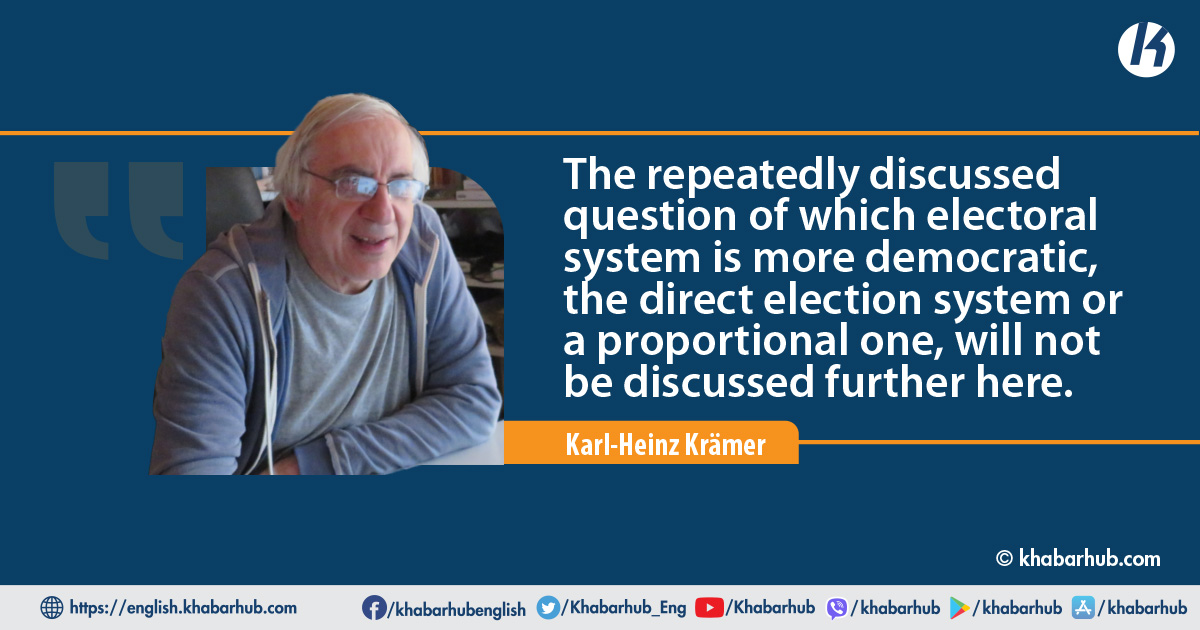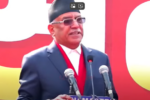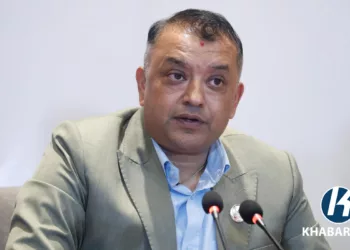In the 2017 elections, a comprehensive election alliance of two major parties, the CPN (UML) and the CPN (MC), was formed for the first time at the national and provincial levels.
The aim of the two parties was to win an absolute majority of seats in this way. Thanks to the extremely disciplined alliance, in the end, it almost achieved a two-thirds majority of seats at the national level.
In six of the seven provinces, the Left Alliance also achieved an absolute majority. The only exception was the present-day Madhesh province.
The Left Alliance of 2017
Social Science Baha (SSB) had asked me to speak to a very interested audience on this issue between the two rounds of elections in late 2017.
At that time, it was already clear that the third major party, the Nepali Congress (NC), would remain pretty much without a chance, at least under the direct election system.
It should also be mentioned that it was the NC and the CPN (UML) who, when the new constitution was adopted, had pushed for a reversal of the number of MPs to be determined by the direct election or PR system.
This was despite the fact that the interim constitution’s arrangement had turned out to be very positive, given the ongoing nepotism and unwillingness of the political parties to be inclusive
Constant power struggles between the top politicians, frequent non-fulfillment of promises, the complete neglect of the actual tasks of government, and, in the end, also increasing breaches of the law and the constitution, as is well known, destroyed the hope for finally more stability in Nepali politics under the Left Alliance government.
But that should not be the topic here.
What is questionable about the planned form of an alliance between the UML and RPP-Nepal is that all jointly selected candidates are to run with the electoral symbol of the UML. From Thapa’s point of view, this seems plausible, as the number of voters willing to vote for his Hindu nationalist ideology is likely to be small, contrary to claims otherwise.
The Left Alliance’s outstanding electoral success was entirely due to the direct election system. If there had been an adjustment of the number of seats won on the basis of the share of the vote under the PR system, as is the case in elections in Germany, for example, the Alliance would probably have achieved at best a narrow absolute majority.
According to the PR system, the NC received only 0.5 percent fewer votes than the CPN (UML), which puts the party’s undisputed electoral defeat in a very different light.
The repeatedly discussed question of which electoral system is more democratic, the direct election system or a proportional one, will not be discussed further here.
Presumably, a mixture of both systems, which has been practiced in Nepal since 2008, is at least a good approach. It was conceived in particular with a view to a reasonably adequate inclusion of all social groups. Concerning the PR system, this has worked with limitations.
The interim constitution had stipulated in Article 63 that the political parties should also observe this inclusion rule when selecting candidates for the direct election system.
However, they disregarded this from the beginning and continue to do so today. The change in the share of seats in favor of the direct election system with the new constitution of 2015 must be seen as deliberate prevention of better political inclusion of all groups in society.
This is also made clear by the fact that the aforementioned passage of the interim constitution on a socially inclusive selection of direct candidates no longer even appears in the new constitution.
The electoral success of the Left Alliance in 2017 has made it clear how easy it is to manipulate election results through the direct election system.
After the introduction of the three-percent hurdle in the PR system, only five parties were able to win seats at the central level through this system.
The two left parties were elected by only 46.9 percent of voters under the PR system but won 63.3 percent of all seats thanks to their alliance under the direct election system. The other three parties entitled to PR seats received 42.7 percent of the PR votes, but only 34.9 percent of all seats.
Possible alliances in 2022
This year, new elections are scheduled at all three levels of the federal system. One gets the impression that the top politicians at the central level see the national whole first and foremost.
This is probably also related to the fact that, on the one hand, there is still a lack of clear delineation of responsibilities and financial sources of the three levels, which must be seen as a failure of the three and a half years of Oli government, but that, on the other hand, the structures of the political parties are also very centralized.
The latter is promoted by the regulations of the Political Party Act, which endows the party leadership with an almost undemocratic amount of power.
Democratically important discussions of opinions dissenting from the party leadership are hardly possible and are quickly punished with draconian punitive measures. The year 2021 revealed this in all its abundance.
It also became clear that the respective central party level controls the provincial level, and to some extent the local level, in every respect.
Even before the official split of the CPN (UML), the factional struggles were also transferred to the two lower levels. This, too, maybe evidence that Nepal is still far from a federal democracy.
The closer this year’s elections get, the more nervous top politicians become when they think about their electoral prospects.
On the one hand, there is the winner of the last national elections, the CPN (UML). Its leader, KP Oli gives himself extreme confidence in victory when he claims that his party will win the elections in a landslide. Reasons for this claim are rather elusive.
Oli has plunged the country into a serious national crisis during his premiership. In the end, any breach of the law and the constitution was fine with him when it came to asserting himself against the party’s internal rivals or former partners to maintain his personal power.
It is hard to imagine that the voters have forgotten this so quickly. So far, the latter has understood the rules of democracy better than the politicians, as the post-1990 elections prove.
Politicians only think of the voters when they need their vote. Each of the mostly utopian election manifestos is no longer worth the paper it was printed on shortly after the elections.
Oli’s former government partners, the CPN (MC) and the split-off CPN (US), have long realized that they could be in for a rude awakening if they contest the elections on their own.
Once again, the direct election system could contribute to the eternally same candidates (characteristic: male, high caste) prevailing with a relatively small share of the vote. In any case, alternatives are offered by the parties only to a limited extent.
The CPN (US) is still a young party and in any case, only represents a small share of the former mother party CPN (UML).
PK Dahal’s CPN (MC) has been on a steady decline since its 2008 high-flying days, from once just under 30 percent to recently only 13.6 percent of the PR vote.
Not much is left of the party’s ideals. A few things like secularism and federalism with simultaneous abolition of the monarchy and Hindu state are on the positive side, but all these aspects continue to look unsecured.
At the same time, the party refuses justice to the victims of the insurgency and has simply forgotten its erstwhile rank and file who risked life and limb at the time.
Meanwhile, the party leadership is basking in luxury and power, engaging in nepotism and corruption much like the top leaders of the other parties.
It is therefore obvious that the latter two parties are desperately seeking an electoral alliance among the current ruling parties.
Such an alliance only makes sense if the Nepali Congress is also on board. Although there were some shifts within this party at the party convention at the end of last year, SB Deuba was able to maintain his leading role. The party has also retained its traditional factionalism.
Thus, the supporters and opponents of a possible electoral alliance within the NC are irreconcilably opposed to each other.
While SB Deuba has more or less embraced an alliance with CPN (MC) and CPN (US), his inner-party rival, Shekhar Koirala, continues to warn against such an alliance, claiming that the NC can successfully contest the elections even if it goes at it alone.
At the same time, it appears as if Deuba is giving in to pressure from government partners, for example when the government suspended the governor of the central bank for no apparent reason.
Federalism was supposed to bring about greater decentralization of political responsibility and better participation of the people at the local and provincial levels.
As long as other parties do not join forces to form an electoral alliance, the NC going it alone might be an option, but there is no guarantee.
On the one hand, it remains to be seen whether the voters will teach the CPN (UML) a lesson given Oli’s endless machinations, but on the other hand, other parties, especially the CPN (MC) and CPN (US), also need an alliance if they want to continue to play a role in the political game.
In the meantime, the need for an electoral alliance also seems to be gaining ground for KP Oli. In the last few days, an agreement to this effect was reached with Kamal Thapa and his RPP-Nepal.
Ideologically, Oli does not seem to be that far away from Kamal Thapa. Oli has repeatedly used Hindu nationalist symbols during his prime ministership and Thapa continues to vehemently advocate a return to the Hindu state, albeit recently without a monarchy.
What is questionable about the planned form of an alliance between the UML and RPP-Nepal is that all jointly selected candidates are to run with the electoral symbol of the UML. From Thapa’s point of view, this seems plausible, as the number of voters willing to vote for his Hindu nationalist ideology is likely to be small, contrary to claims otherwise.
The parent party RPP, from which Thapa recently parted ways after being voted out as chairman, achieved just two percent of the PR vote in 2017. It is unlikely to get much more this time either. Besides, there is still competition from the RPP in the immediate ideological camp.
A critical aspect is that, according to this agreement, RPP-Nepal candidates are to run with the electoral symbol of the CPN (UML), i.e. candidates who can be assumed to still be deeply rooted in the Hindu nationalist ideology of the RPP-Nepal.
The election symbols stand for a party, not an alliance. The plan of the CPN (UML) and RPP-Nepal looks like an attempted fraud or at least like a deliberate misleading of the voters.
National election alliances on the local level
At the national and probably also at the provincial level, electoral alliances seem to make sense in today’s situation, at least from the power perspective of the parties and their top politicians.
The whole discussion, however, is somewhat overshadowed by the fact that the first election to be held in May will be at the local level. The question is what sense the alliances agreed upon at the central national level make at the local level.
One cannot rid oneself of the feeling that all this is an expression of the top politicians’ lack of understanding of the federal state.
Women would have to suffer another bitter setback with regard to better political participation. The top central politicians would also have successfully undermined the hopeful inclusion scheme at the local level.
Federalism was supposed to bring about greater decentralization of political responsibility and better participation of the people at the local and provincial levels.
However, the concerns and problems of the people are very different depending on the locality and region. Alliances imposed by the central party leadership can only be a hindrance.
It would be better if electoral alliances could be formed at the local level, or not, as the case may be. Such a decision, as in any democratic state, should be taken by the local grassroots and not by the party leadership.
And such decisions must be made with great deliberation. It is already apparent in the preliminary negotiations that there is a threat of further undermining of the socially inclusive PR system at the local level.
When parties form alliances, they put up, for example, only one joint candidate for mayor and one for deputy mayor, presumably distributed among the parties involved in the alliance.
Thus, if subsequently the parties each run for only one of the two posts, the constitutional obligation to nominate candidates of different genders could be dropped.
Since all parties are almost exclusively dominated and controlled by men, it is likely that the majority of candidates for both posts would be male.
Women would have to suffer another bitter setback with regard to better political participation. The top central politicians would also have successfully undermined the hopeful inclusion scheme at the local level.









Comment